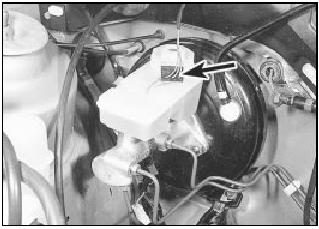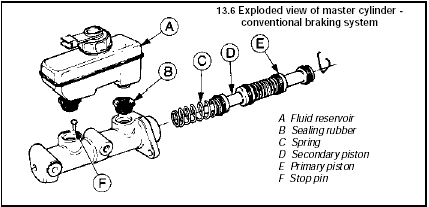Master cylinder (conventional braking system) - removal, overhaul and refitting
Note: Before commencing overhaul obtain a repair kit containing new pistons and seals.
Caution: Refer to the
precautions in Section 1.
Removal
1 Depress the brake pedal several times to
dissipate the vacuum in the servo.
2 Disconnect the wiring plug from the low fluid level switch on the fluid reservoir cap (see illustration).

13.2 Disconnect the wiring plug from the low fluid level switch (arrowed)
3 Place a suitable container beneath the master cylinder, then unscrew the union nuts and disconnect the two fluid pipes. Plug the ends of the pipes to prevent dirt ingress.
4 Unscrew the two mounting nuts and spring washers, and withdraw the master cylinder from the servo. Cover the master cylinder with rag or a plastic bag to prevent spillage of hydraulic fluid on the vehicle paintwork. If fluid is accidentally spilt on the paintwork, wash off immediately with cold water.
Overhaul
5 Drain the remaining fluid from the master
cylinder, and clean the exterior surfaces with
methylated spirit.
6 Pull the fluid reservoir from the top of the master cylinder and prise out the sealing rubbers (see illustration).

13.6 Exploded view of master cylinder - conventional braking system
A Fluid reservoir
B Sealing rubber
C Spring
D Secondary piston
E Primary piston
F Stop pin
7 Mount the master cylinder in a vice, then depress the primary piston slightly and extract the circlip and washer. Withdraw the primary piston assembly.
8 Depress the secondary piston and remove the stop pin from the fluid aperture.
9 Remove the master cylinder from the vice and tap it on the bench to remove the secondary piston assembly.
10 Prise the seals from the secondary piston.
Do not attempt to dismantle the primary piston.
11 Clean all the components in methylated spirit and examine them for wear and damage. In particular check the surfaces of the pistons and cylinder bore for scoring and corrosion. If the cylinder bore is worn, renew the complete master cylinder, otherwise obtain a repair kit including pistons and seals.
12 Check that the fluid inlet and outlet ports are free and unobstructed. Dip the new pistons and seals in clean brake fluid.
13 Fit the seals to the secondary piston using the fingers only to manipulate them into the grooves. Note that the sealing lips must face away from each other.
14 Insert the secondary piston and spring into the cylinder. Turn the piston slowly as the first seal enters to avoid trapping the sealing lip. Similarly insert the primary piston and spring, then fit the washer and circlip.
15 Depress the primary and secondary pistons and refit the secondary piston stop pin.
16 Fit the fluid reservoir sealing rubbers and press the reservoir into them. If the rubbers are worn or perished, or if leakage has been evident, fit the new rubbers.
Refitting
17 Refitting is a reversal of removal but
tighten the mounting nuts and pipe union nuts
to the specified torque and finally bleed the
hydraulic system.
See also:
Front seat air cushion assembly - removal and refitting
Complete assembly - removal and
refitting
1 Remove the seat.
2 Straighten the seat back cover retaining
tangs, and pull the cover upwards to expose
the air cushion.
3 Cut through the four securi ...
Cleaning
WASHING THE EXTERIOR
Wash your vehicle regularly with cool or lukewarm water and a neutral
Ph shampoo, such as Motorcraft Detail Wash (ZC-3-A), which is available
from your dealer.
Never use st ...
Front suspension lower arm (forged type) - removal, overhaul
and refitting
1 The forged type suspension arm is fitted to
all models except pre-May 1983 1.1 litre
versions.
Removal
2 Jack up the front of the car and support it
on stands (see “Jacking and Vehicle Support” ...
